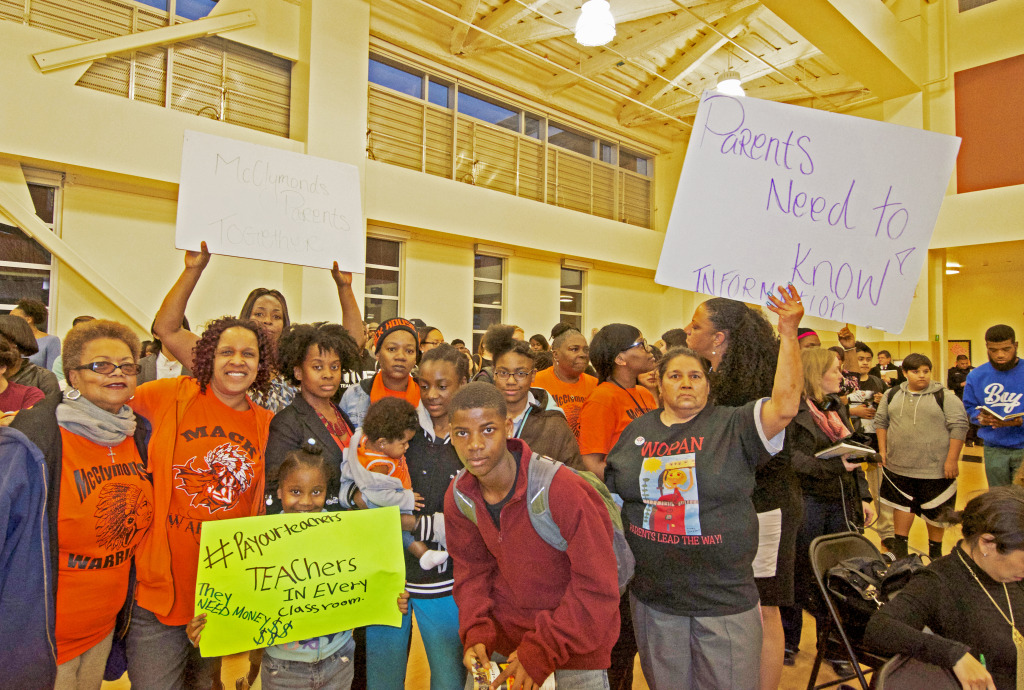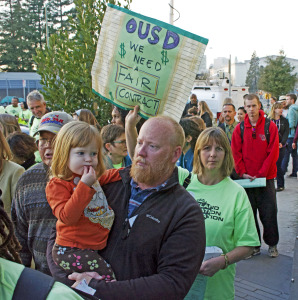Oakland School District Faces Conflict Over Teacher Pay and “Redesign” of Five Schools
Feb 1, 2015
Posted in Uncategorized

By Ken Epstein
The Oakland Unified School District’s three new school board members and newly hired superintendent have taken their positions just as two of the district’s most protracted conflicts are coming to a head: poorly paid teachers are demanding decent pay and job security, and communities at five schools are fed up with district-led reorganizations that have repeatedly disrupted and destabilized their schools over the last decade.
Most everyone agrees that Oakland’s teachers desperately need a raise. According to the teachers’ union, they are the lowest-paid in Alameda County and lowest-paid in the nine-county Bay Area.
As a result, the district has a 20 percent turnover rate each year, meaning the schools are stuck on a treadmill, hiring and recruiting mostly inexperienced teachers.
Angry teachers came out in force Wednesday night, marching down Park Boulevard to rally and speak at this week’s Board of Education meeting at La Escuelita Education Center.
In protest, teachers at many schools are staging a slowdown, called “work to rule,” coming at the beginning of the school day and leaving when school ends, not giving or correcting homework or doing any of the myriad other tasks they generally do.

The district is offering a 10 percent raise over three years – 3 percent this year, starting in January; 3 percent next January; and 4 percent the following year, depending on the funds that come from the state.
Oakland Education Association (OEA) President Trish Gorham says the mid-year 3 percent raise this year does not keep up with the 3.25 percent other Bay Area teachers have received this year.
“That just makes us fall further behind,” she said.
Supt. Antwan Wilson responded to teachers at the meeting and in an email to the school community.
“We need to finalize these negotiations so that we can focus all of our energy on the work that is before us to ensure quality schools for all – and there is a lot of work to do,” he wrote.
“I remain committed to making Oakland the leader in attracting, retaining and rewarding the best talent,” he continued. “While this vision cannot be achieved overnight, it is possible.”
He pointed to the constraints the district is facing. “We can’t forget that California remains 46th out of 50 states in per pupil spending.” Further, he said the district still has to give $6 million per year to the state to repay the $100 million bailout OUSD received when it went into bankruptcy and was taken over by the state in 2003.
In addition to salaries, OEA President Gorham says teachers are concerned about the district’s desire to weaken teacher transfer provisions in the contract, allowing the administration to unilaterally and involuntarily remove teachers from schools and weaken seniority rights to open positions.
The three high schools facing “redesign” this year – Fremont, McClymonds and Castlemont – were reconstituted three years ago, and every teacher had to reapply for their job.
Now the district is going to do it again, Gorham said. “Where is the analysis of what they did then? What is going to happen to the teachers who don’t want to leave their school sites and are forced to leave?”
The administration and the school board have admitted that they have to do a better job explaining their plans to “transform” five “failing” schools this year – Brookfield Elementary and Frick Middle schools, in addition to the two East Oakland and one West Oakland high schools.
There is general agreement that Oakland’s schools must make deep changes in order to improve graduation rates and post-secondary admission rates, particularly for African American and Latino students.
But that is where the consensus ends. A group of students from Fremont High and other schools came to this week’s board meeting to oppose the administration’s plan. A group from the McClymonds community called on the district to explain what it is planning and to include the community in making the changes.
The districts plan calls for an open competition period to submit school redesign proposals, starting in February. Charter schools and other outside organizations are eligible to apply to run the schools.
This approach was adopted by the school board in 2013 and re-approved in 2014 under the leadership of then Board President David Kakishiba and acting Supt Gary Yee. Supt. Wilson was hired to implement it.
District spokesman Troy Flint told the Post that no school would be forced to become a charter over community opposition. If a school is opposed to “the idea of charter, it would naturally follow that a charter proposal would not prevail in the selection process at that particular school,” he said.
State law permits groups of parents or teachers at individual schools to apply to become a charter, said Gorham. But the district is adopting an approach that does not exist in the law: open up a competition for charters to submit applications, and the board and superintendent will make the decision.
According to Gorham and others, the district plan dooms the existing schools. “If you publically call them ‘failing schools,’ how many parents are going to enroll their kids in the schools next year?”
“It’s a self-fulfilling prophecy. You destabilize, reconstitute, and then you convert to charter,” said Gorham.
Instead, a number of the opponents of the plan say the district should listen respectfully with the school communities, find out what they need, and pour in resources and other support to make them schools that students want to attend and where parents want to send their children.
Flint denied that anyone at OUSD referred to the schools as failing.
“I’m not aware of anyone publicly referring to these schools as ‘failing schools.’ Perhaps this was mentioned at a meeting I didn’t attend, but that’s not what we’ve been saying in our official communications,” he wrote to the Post. “We do refer to patterns of relatively low academic performance and under-enrollment.”